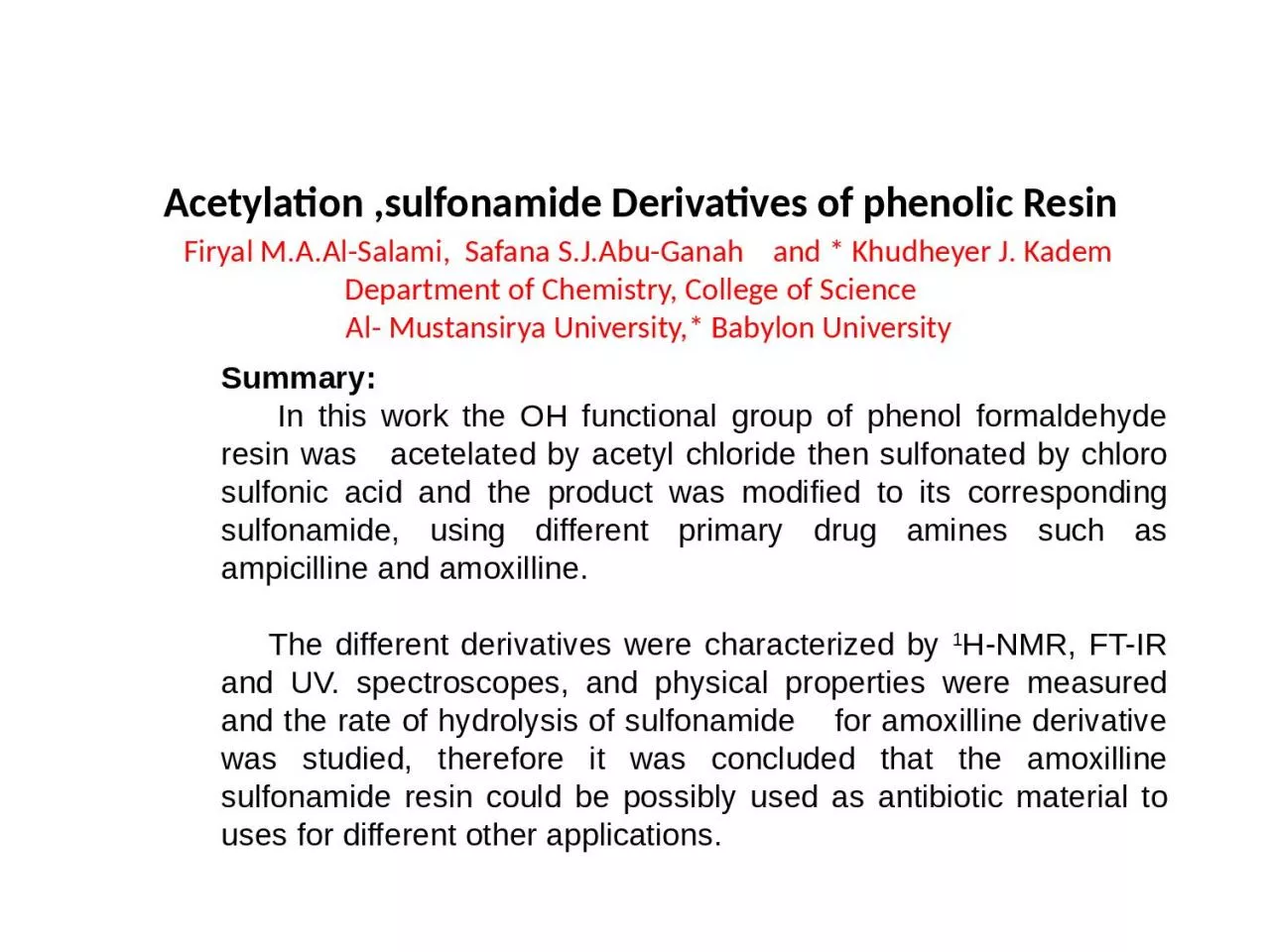

phenolic Resin Firyal MAAl Salami Safana SJAbuGanah and Khudheyer J Kadem Department of Chemistry College of Science Al Mustansirya University Babylon University ID: 933273
Download Presentation The PPT/PDF document "Acetylation ,sulfonamide Derivatives of" is the property of its rightful owner. Permission is granted to download and print the materials on this web site for personal, non-commercial use only, and to display it on your personal computer provided you do not modify the materials and that you retain all copyright notices contained in the materials. By downloading content from our website, you accept the terms of this agreement.
Slide1
Acetylation ,sulfonamide Derivatives of phenolic ResinFiryal M.A.Al-Salami, Safana S.J.Abu-Ganah and * Khudheyer J. KademDepartment of Chemistry, College of Science Al- Mustansirya University,* Babylon University
Summary:
In this work the OH functional group of phenol formaldehyde resin was
acetelated
by acetyl chloride then
sulfonated
by
chloro
sulfonic
acid and the product was modified to its corresponding sulfonamide, using different primary drug amines such as
ampicilline
and
amoxilline
.
The different derivatives were characterized by
1
H-NMR, FT-IR and UV. spectroscopes, and physical properties were measured and the rate of hydrolysis of sulfonamide for
amoxilline
derivative was studied, therefore it was concluded that the
amoxilline
sulfonamide resin could be possibly used as antibiotic material to uses for different other application
s.
Slide2Acetylation of novolac P1
:
5gm. of supplied
novolac was dissolved in 10ml of DMF ,1:1 molar ratio of acetyl chloride was added gradually in a round bottomed flask which was equipped with condenser, stirred about 30mins., the excess of acetylchloride was distilled off. The red resin was isolated with 90% conversion. Sulfonation of acetylated phenol formaldehyde resin P2 Five grams of acetylated novolac was dissolved in 10 ml of dioxane to obtain high Liquidity, then the 4ml of chlorosulfonic acid was added gradually with continuous stirring to ensure maximum homogeneity through out the resin at 0 0C the viscose resulting sample was obtained then dried the sample in vacuum oven at 50 0C.
EXPERIMENTAL
Slide3Preparation of N-Substituted acetylated phenol formaldehyde sulfonamide resins. P3-P4 .
A mixture of
sulfonated
novolac (5g, 0,025 mole) and 20 ml of dioxane , and (0,025 mole) of some primary amine such as ampicilline or amoxilline was added to reaction mixture , refluxed with stirring about 15 mins. by using water bath ,then evaporated the solvent, the colored polymeric precipitate was isolated, washed and dried in a vacuum oven. Table 1 shows the physical properties of prepared N-sulfonamide acetylated phenol formaldehyde resins
Slide4[η in]dl/g Softening point 0C
Conversion %
Color
Ar- NH2Polymer.No.0.81>30070 redamoxicillin
P3
0.78
>30075orangeampicillin P4
Table (1) :Physical properties of prepared N-Substituted sulfonamide of acetylated phenolic resins .
Slide5S%1day
2day
3day
4dayS% P34.16.78.110
S% P
4
5.26.07.89
Swelling studies Dynamic swelling studies of prepared resins made as follows:- Resins were swollen in different at 37 0C remove from the water bath at regular intervals were dried superficially with filter paper. Weighted and placed in the same bath.
The swelling S% is calculated from the following equation:
S %= (M
1
-M
0
)/M
0
* 100
Where M
0
is the mass of dry resin at time 0 .
M
1
is the mass of swollen resin at time t .
Swelling curves of
amoxilline
and
ampicilline
resin in solution water at
37
0
C. Table (2) shows the swelling % of polymer P
3
and P
4
in pH4 (acidic medium).
Table(2): Swelling% of P
3
and P
4
in acidic medium pH4
Release studies
[11]
50 mg of
amoxilline
- acetylated phenol formaldehyde sulfonamide was placed in 100 ml of buffer solution with pH 4 at 37
0
C .At periodic intervals 3 ml of solution of resin with drawing and tested λ
max
= 300 nm using UV-VIS- spectrophotometer, the release studies were continued for four days .
Slide6In this work the supplied phenol formaldehyde (novolac) was acetylated and sulfonated with
chlorosufonic
acid as described in the following scheme (1)-
Slide7The sulfonated resin was modified with some primary drug amines such as ampicillin or amoxilline as antibiotic drug which carried amino group , the reaction was shown below:-
Slide8The mechanism[12,13]of hydrolysis is shown in the following Scheme (2,3):-
Scheme (2) shows the mechanism of releasing amoxilline from sulfonamide resin, in acidic media, H+ is bonded to oxygen atom of sulfonamide group, and increase, the positive charge of sulfur atom, then enhanced the nucleophilic attack of water. Scheme (3) shows the mechanism of releasing amoxilline in basic medium which is stronger nueleophilic
in respect to water, the rate of hydrolysis takes place faster than acidic, as shown in Fig (4), for P
3,
P4 resin.
Slide9Conclusions: The P-N-substituted sulfonamide acetylated phenolic
resin were synthesized as antibiotic agents, the novel functional polymers as biomaterial have many application, that exhibit pharmacologic properties or that can be utilized as carriers for selective and sustained delivery agents with greater specify of action
.
Slide10Fig(1)Sulfonated phenol Formaldehyde resine P2
Slide11Fig (2): Sulphonated resine with amoxcilline
Slide12Fig (3): Acetylated phenol Formaldehyde resin ampicilline sulfonamide P3
Slide13a-P3&P4 in pH4.
b- P3&P4 in pH 10.
Fig (4): Controlled drug release of P3&P4 at 37
0C in a-pH4 and b-pH10
Slide14Fig(5) 1H-NMR spectrum of P3
Slide15THANK YOU FOR LESTENING